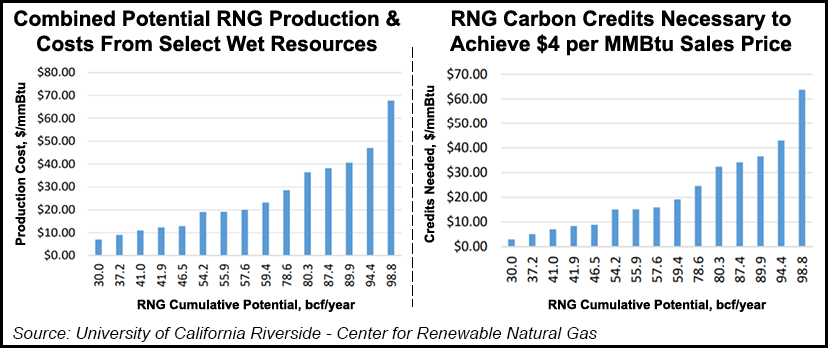Infrastructure | NGI All News Access
Study Shows Long-Term Viability of RNG in California
California Gov. Jerry Brown signed 16 bills covering zero-emission vehicles (ZEV) and climate change mitigation efforts last week, as university researchers published a study verifying the long-term viability of renewable natural gas (RNG) sources in the state.

On Thursday, Brown used the deck of a plug-in hybrid electric ferry in San Francisco Bay to sign the ZEV and climate change measures passed by the legislature last month. The signing ceremony was an offshoot of the three-day Global Climate Action Summit, which ended in San Francisco Friday.
The University of California-Riverside’s Center for Renewable Natural Gas (CRNG) issued a glowing report on California’s potential for producing RNG through an extensive network of landfills and dairies.
“The study shows that RNG from existing resources can play a key role in helping the state achieve its climate and renewable energy goals,” said lead author Arun Raju.
California’s investor-owned utilities maintain gas quality standards to ensure any RNG added to their pipeline systems is interchangeable with traditionally sourced natural gas. Southern California Gas Co. (SoCalGas) connects to an RNG production facility in Perris, CA, and RNG from other states is brought into the SoCalGas system on a regular basis.
More than 70% of the natural gas vehicle (NGV) trucks operating in the state use RNG.
California has two commercial-scale biogas production projects with on-site electric generation. The Point Loma Wastewater Treatment Plant injects RNG into a utility pipeline to power a 2.8 MW fuel cell at the University of California-San Diego. Meanwhile, the City of Los Angeles has a biogas-fueled cogeneration system at its Hyperion Water Reclamation Plant, the state’s largest. The system captures at least 7.5 MMcf of methane created naturally by wastewater and uses RNG to produce the 22 MW of power needed to operate the treatment facility.
The CRNG study confirms that RNG can play a more comprehensive role not only for transportation, but also building, commercial and industrial end-uses.
Next month, SoCalGas, Pacific Gas and Electric Co. (PG&E) and nonprofit Energy Vision will host the third annual “Power of Waste” conference to explore various “high-value end-use” markets for RNG.
“RNG is ripe for further development in California, and SoCalGas wants to connect to as many biogas operations as possible,” said SoCalGas Vice President Sharon Tomkins.
During the signing ceremony, Brown said all forms of transportation need to decarbonize, whether it’s cars, buses or boats. “These bills will help get more clean cars on the road and reduce harmful emissions,” the governor said.
Los Angeles officials involved with the planning for the 2028 Olympics have created a clean transportation partnership with the California Air Resources Board (CARB), the state’s largest utilities, the mayor’s office and the Los Angeles Cleantech Incubator. The partnership is putting together a Zero Emissions 2028 Roadmap.
The Olympics transportation partnership is attempting to piggyback on the state’s ongoing transportation electrification and statewide zero emission goods movement programs.
One of the programs calls for moving to zero emission trucks at the Los Angeles and Long Beach Ports, which combined are the nation’s largest shipping hub. NGV advocates, including Washington, DC-based NGVAmerica, are heavily boosting the work done by Cummins Westport to develop near-zero emission NGV engines, particularly the new 12-liter one for heavy duty vehicles.
“The NGV industry has taken a proactive approach to not just meeting but exceeding emissions standards, and the results of the [University of California-Riverside] study confirm the important environmental achievements realized by this approach,” said NGVAmerica President Dan Gage.
Most heavy duty vehicles today are still powered by diesel, so the transportation sector is one of the largest sources of nitrogen oxide emissions and fuel consumption in North America. Gage and NGVAmerica see this as a huge opportunity for near-zero emission engines in heavy duty NGV trucks, buses and refuse-hauling vehicles.
© 2024 Natural Gas Intelligence. All rights reserved.
ISSN © 1532-1231 | ISSN © 2577-9877 |
